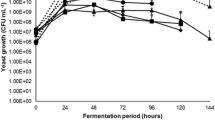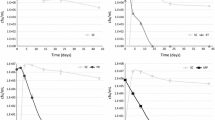Abstract
The aim of the present study was to assess the effect of sulfur dioxide addition in the wild yeast population dynamics as well as the polyphenolic composition during spontaneous red wine fermentation from Vitis vinifera cultivar Agiorgitiko. The grapes were crushed and fermentation took place at 21 °C without the addition of any commercial yeast, and with and without the addition of 40 mg L−1 SO2. A combination of culture-dependent and culture-independent techniques was used for wild yeast population dynamics assessment and HPLC analysis for the determination of polyphenolic compounds. Regarding the former, the effect of sulfur dioxide addition was only marginal since Saccharomyces cerevisiae strains dominated the fermentation from the first day; strains belonging to Hanseniaspora spp., Lachancea thermotolerans and Metschnikowia pulcherrima species appeared only occasionally. As far as the polyphenolic content was concerned, it was enhanced with sulfur dioxide addition; however, as time progressed, the differences were reduced, suggesting that the time the juice was in contact with the skins was of greater importance than sulfur dioxide addition.



Similar content being viewed by others
References
Fleet GH, Heard GM (1993) Yeasts—growth during fermentation. In: Fleet GH (ed) Wine microbiology and biotechnology. Harwood Academic Publishers, Chur, pp 27–55
Pretorius IS (2000) Tailoring wine yeast for the new millennium: novel approaches to the ancient art of winemaking. Yeast 16:675–729
Beltran G, Torija MJ, Novo M, Ferrer N, Poblet M, Guillamon JM, Rozes N, Mas A (2002) Analysis of yeast populations during alcoholic fermentation: a six year follow-up study. Syst Appl Microbiol 25:287–293
Rementeria A, Rodriguez JA, Cadaval A, Amenabar R, Muguruza JR, Hernando FL, Sevilla MJ (2003) Yeast associated with spontaneous fermentations of white wines from the ‘‘Txakoli de Bizkaia’’ region (Basque Country, North Spain). Int J Food Microbiol 86:201–207
Nisiotou AA, Spiropoulos AE, Nychas GJE (2007) Yeast community structures and dynamics in healthy and Botrytis-affected grape must fermentations. Appl Environ Microbiol 73:6705–6713
Blanco P, Miras-Avalos JM, Orriols I (2012) Effect of must characteristics on the diversity of Saccharomyces strains and their prevalence in spontaneous fermentations. J Appl Microbiol 112:936–944
Bokulich NA, Hwang CF, Liu S, Boundy-Mills KL, Mills DA (2012) Profiling the yeast communities of wine fermentations using terminal restriction fragment length polymorphism analysis. Am J Enol Vitic 63:185–194
Sun Y, Liu Y (2014) Investigating of yeast species in wine fermentation using terminal restriction fragment length polymorphism method. Food Microbiol 38:201–207
Cocolin L, Bisson LF, Mills DA (2000) Direct profiling of yeast dynamics in wine fermentations. FEMS Microbiol Lett 189:81–87
Di Maro E, Ercolini D, Coppola S (2007) Yeast dynamics during spontaneous wine fermentation of the Catalanesca grape. Int J Food Microbiol 117:201–210
Callon C, Delbes C, Duthoit F, Montel MC (2006) Application of SSCP-PCR fingerprinting to profile the yeast community in raw milk Salers cheeses. Syst Appl Microbiol 29:172–180
Zott K, Claisse O, Lucas P, Coulon J, Lonvaud-Funel A, Masneuf-Pomarede I (2010) Characterization of the yeast ecosystem in grape must and wine using real-time PCR. Food Microbiol 27:559–567
Salaha MI, Kallithraka S, Marmaras I, Koussissi E, Tzourou I (2008) A natural alternative to sulphur dioxide for red wine production: influence on colour, antioxidant activity and anthocyanin content. J Food Compos Anal 21:660–666
Tao J, Dykes S, Kilmartin PA (2007) Effect of SO2 concentration on polyphenol development during red wine micro-oxygenation. J Agric Food Chem 55:6104–6109
Coetzee C, Lisjak K, Nicolau L, Kilmartin P, Johannes du Toit W (2013) Oxygen and sulfur dioxide additions to Sauvignon blanc must: effect on must and wine composition. Flavour Frag J 28:155–167
Cocolin L, Mills DA (2003) Wine yeast inhibition by sulfur dioxide: a comparison of culture-dependent and independent methods. Am J Enol Vitic 54:125–130
Koundouras S, Marinos V, Gkoulioti A, Kotseridis Y, Van Leeuwen C (2006) Influence of vineyard location and vine water status on fruit maturation of nonirrigated cv. Agiorgitiko (Vitis vinifera L.). Effects on wine phenolic and aroma components. J Agric Food Chem 54:5077–5086
Koundouras S, Kanakis I, Drossou E, Kallithraka S, Kotseridis Y (2013) Effects of postveraison water regime on the phenolic composition of grapes and wines of cv. Agiorgitiko (Vitis Vinifera L.). J Int Sci Vigne Vin 47:115–128
Petropoulos S, Kallithraka S, Paraskevopoulos I (2011) Influence of some viticultural practices on the polyphenolic content of wines produced from cv. Agiorgitiko (Vitis vinifera L.). J Int Sci Vigne Vin 45:235–243
Assimakopoulou A, Nifakos K, Agelopoulos. K (2012) Inorganic nutrition differences between own-rooted and grafted vineyards of the Greek wine grape cultivar ‘Agiorgitiko’. Acta Hortic 931:267–272
Paramithiotis S, Mueller MRA, Ehrmann MA, Tsakalidou E, Seiler H, Vogel R, Kalantzopoulos G (2000) Polyphasic identification of wild yeast strains isolated from Greek sourdoughs. Syst Appl Microbiol 23:156–164
Paramithiotis S, Tsiasiotou S, Drosinos EH (2010) Comparative study of spontaneously fermented sourdoughs originating from two regions of Greece; Peloponnesus and Thessaly. Eur Food Res Technol 231:883–890
Office International de la Vigne et du Vin (1990) Le recueil des méthodes internationales d’analyse des vins et des moûts. O.I.V., Paris
Makris DP, Psarra E, Kallithraka S, Kefalas P (2003) The effect of polyphenolic composition as related to antioxidant capacity in white wines. Food Res Int 36:805–814
Kallithraka S, Mohdaly AAA, Makris DP, Kefalas P (2005) Determination of major anthocyanin pigments in Hellenic native grape varieties (Vitis vinifera sp.): association with antiradical efficiency. J Food Compos Anal 18:375–386
Kallithraka S, Tsoutsouras E, Tzourou E, Lanaridis P (2006) Principal phenolic compounds in Greek red wines. Food Chem 99:784–793
Egli CM, Edinger WD, Mitrakul CM, Henick-Kling T (1998) Dynamics of indigenous and inoculated yeast populations and their effects on the sensory character of Riesling and Chardonnay wines. J Appl Microbiol 85:779–789
Bezerra-Bussoli C, Alves Baffi M, Gomes E, Da-Silva R (2013) Yeast diversity isolated from grape musts during spontaneous fermentation from a Brazilian winery. Curr Microbiol 67:356–361
Lopandic K, Tiefenbrunner W, Gangl H, Mandl K, Berger S, Leitner G, Abd-Ellah GA, Querol A, Gardner RC, Sterflinger K, Prillinger H (2008) Molecular profiling of yeasts isolated during spontaneous fermentations of Austrian wines. FEMS Yeast Res 8:1063–1075
Sabate J, Cano J, Querol A, Guillamon JM (1998) Diversity of Saccharomyces cerevisiae strains in wine fermentations: analysis for two consecutive years. Lett Appl Microbiol 26:452–455
Fleet GH (2003) Yeast interactions and wine flavor. Int J Food Microbiol 86:11–22
Combina M, Elia A, Mercado L, Catania C, Ganga A, Martinez C (2005) Dynamics of indigenous yeast populations during spontaneous fermentation of wines from Mendoza, Argentina. Int J Food Microbiol 99:237–243
Clavijo A, Calderon IL, Paneque P (2010) Diversity of Saccharomyces and non-Saccharomyces yeasts in three red grape varieties cultured in the Serrania de Ronda (Spain) vine-growing region. Int J Food Microbiol 143:241–245
Li EH, Liu AG, Xue B, Liu YL (2011) Yeast species associated with spontaneous wine fermentation of Cabernet Sauvignon from Ningxia, China. World J Microbiol Biotechnol 27:2475–2482
Clemente-Jimenez JM, Mingorance-Cazorla L, Martinez-Rodriguez S, Las Heras-Viazquez FJ, Rodriguez-Vico F (2004) Molecular characterization and oenological properties of wine yeasts isolated during spontaneous fermentation of six varieties of grape must. Food Microbiol 21:149–155
Urso R, Rantsiou K, Dolci P, Rolle L, Comi G, Cocolin L (2008) Yeast biodiversity and dynamics during sweet wine production as determined by molecular methods. FEMS Yeast Res 8:1053–1062
Cadez N, Poot GA, Raspor P, Smith MT (2003) Hanseniaspora meyeri sp. nov., Hanseniaspora clermontiae sp. nov., Hanseniaspora lachancei sp. nov. and Hanseniaspora opuntiae sp. nov., novel apiculate yeast species. Int J Syst Evol Microbiol 53:1671–1680
Kurtzman CP (2003) Phylogenetic circumscription of Saccharomyces, Kluyveromyces and other members of the Saccharomycetaceae, and the proposal of the new genera Lachancea, Nakaseomyces, Naumovia, Vanderwaltozyma and Zygotorulaspora. FEMS Yeast Res 4:233–245
Gobbi M, Comitini F, Domizio P, Romani C, Lencioni L, Mannazzu I, Ciani M (2013) Lachancea thermotolerans and Saccharomyces cerevisiae in simultaneous and sequential co-fermentation: a strategy to enhance acidity and improve the overall quality of wine. Food Microbiol 33:271–281
Ercolini D (2004) PCR-DGGE fingerprinting: novel strategies for detection of microbes in food: a review. J Microbiol Methods 56:297–314
Giraffa G, Carminati D (2008) Molecular techniques in food fermentation: principles and applications. In: Cocolin L, Ercolini D (eds) Molecular techniques in the microbial ecology of fermented foods. Springer, New York, pp 1–30
Andorra I, Landi S, Mas A, Guillamon JM, Esteve-Zarzoso B (2008) Effect of oenological practices on microbial populations using culture independent techniques. Food Microbiol 25:849–856
Nieminen TT, Vihavainen E, Paloranta A, Lehto J, Paulin L, Auvinen P, Solismaa M, Bjorkroth KJ (2011) Characterization of psychrotrophic bacterial communities in modified atmosphere-packed meat with terminal restriction length polymorphism. Int J Food Microbiol 144:360–366
Doulgeraki AI, Ercolini D, Nychas GJE, Villani F (2012) Spoilage microbiota associated to the storage of raw meat in different conditions. Int J Food Microbiol 157:130–141
Doulgeraki AI, Nychas GJE (2013) Monitoring the succession of the biota grown on a selective medium for pseudomonads during storage of minced beef with molecular-based methods. Food Microbiol 34:62–69
Divol B, Lonvaud-Funel A (2005) Evidence for viable but non culturable yeasts in botrytis-affected wine. J Appl Microbiol 99:85–93
Bakker J, Bridle P, Bellworthy SJ, Garcia-Viguera C, Reader HP, Watkins SJ (1998) Effect of sulphur dioxide and must extraction on colour, phenolic composition and sensory quality of red table wine. J Sci Food Agric 78:297–307
Ribereau-Gayon P, Glories Y, Maujean A, Dubourdieu D (2000) Handbook of enology, vol 2. Wiley, England
Acknowledgments
The authors are grateful to Estate Pirgaki, located on Asprokampos, Nemea, for supplying the grapes and to the Director of the Laboratory of Microbiology and Biotechnology of Foods, Professor G.-J. E. Nychas for provision of recourses for the implementation of the study.
Conflict of interest
None.
Compliance with Ethics Requirements
This article does not contain any studies with human or animal subjects.
Author information
Authors and Affiliations
Corresponding author
Rights and permissions
About this article
Cite this article
Pateraki, C., Paramithiotis, S., Doulgeraki, A.I. et al. Effect of sulfur dioxide addition in wild yeast population dynamics and polyphenolic composition during spontaneous red wine fermentation from Vitis vinifera cultivar Agiorgitiko. Eur Food Res Technol 239, 1067–1075 (2014). https://doi.org/10.1007/s00217-014-2303-z
Received:
Revised:
Accepted:
Published:
Issue Date:
DOI: https://doi.org/10.1007/s00217-014-2303-z




